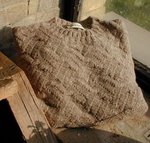Lozenge
|
|

A lozenge is a rhombus which usually has two corners pointing up and down that are farther apart than the corners pointing sideways. It is often used in parquetry and as decoration on ceramics, silverware, and textiles.
| Contents |
Applications
Camouflage
During the First World War, the Germans were looking for a way to effectively camouflage their aircraft. This resulted in the development of the so-called lozenge pattern, made up of irregular painted polygons. Because painting such a pattern was very time consuming, and the paint added considerably to the weight of the aircraft, it was decided to print the pattern on a fabric. This pre-printed fabric was used from 1916 onwards, in various forms and colours, like the one pictured on the right.
Heraldry
Main article: Lozenge (heraldry)
The lozenge in heraldry is a diamond-shaped charge, usually somewhat narrower than it is tall. A mascle is a voided lozenge-- that is, a lozenge with a lozenge-shaped hole in the middle-- and the rarer rustre is a lozenge containing a circular hole. A field covered in a pattern of lozenges is described as lozengy; a similar field of mascles is masculy.
Cough tablets
Main article: Cough drop
Cough tablets have taken the name lozenge, based on their original shape. According to the Oxford English Dictionary the first use of this sense was in 1530.
The glyph
The lozenge glyph is found in DOS code page 437 and Mac-Roman. It is also found at Unicode 0x25CA and can be typed with ◊ (or ◊), which will produce ◊.

